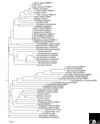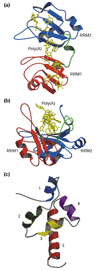Poly(A)-binding proteins: multifunctional scaffolds for the post-transcriptional control of gene expression
- PMID: 12844354
- PMCID: PMC193625
- DOI: 10.1186/gb-2003-4-7-223
Poly(A)-binding proteins: multifunctional scaffolds for the post-transcriptional control of gene expression
Abstract
Most eukaryotic mRNAs are subject to considerable post-transcriptional modification, including capping, splicing, and polyadenylation. The process of polyadenylation adds a 3' poly(A) tail and provides the mRNA with a binding site for a major class of regulatory factors, the poly(A)-binding proteins (PABPs). These highly conserved polypeptides are found only in eukaryotes; single-celled eukaryotes each have a single PABP, whereas humans have five and Arabidopis has eight. They typically bind poly(A) using one or more RNA-recognition motifs, globular domains common to numerous other eukaryotic RNA-binding proteins. Although they lack catalytic activity, PABPs have several roles in mediating gene expression. Nuclear PABPs are necessary for the synthesis of the poly(A) tail, regulating its ultimate length and stimulating maturation of the mRNA. Association with PABP is also a requirement for some mRNAs to be exported from the nucleus. In the cytoplasm, PABPs facilitate the formation of the 'closed loop' structure of the messenger ribonucleoprotein particle that is crucial for additional PABP activities that promote translation initiation and termination, recycling of ribosomes, and stability of the mRNA. Collectively, these sequential nuclear and cytoplasmic contributions comprise a cycle in which PABPs and the poly(A) tail first create and then eliminate a network of cis- acting interactions that control mRNA function.
Figures




References
-
- The Jacobson lab - additional data http://jacobsonlab.umassmed.edu/cgi-bin/dbcontents.cgi?gencon-tents=PABPs Fasta data and links to poly(A)-binding protein sequences are available on this website.
-
- Kleene KC, Mulligan E, Steiger D, Donohue K, Mastrangelo MA. The mouse gene encoding the testis-specific isoform of poly(A) binding protein (Pabp2) is an expressed retroposon: intimations that gene expression in spermatogenic cells facilitates the creation of new genes. J Mol Evol. 1998;47:275–281. This article reports the characterization of mouse testis-specific PABP2 isoform. - PubMed
-
- Blanco P, Sargent CA, Boucher CA, Howell G, Ross M, Affara NA. A novel poly(A)-binding protein gene (PABPC5) maps to an X-specific subinterval in the Xq21.3/Yp11.2 homology block of the human sex chromosomes. Genomics. 2001;74:1–11. The human PABPC5 was localized to the X chromosome. - PubMed
Publication types
MeSH terms
Substances
Grants and funding
LinkOut - more resources
Full Text Sources
Other Literature Sources

